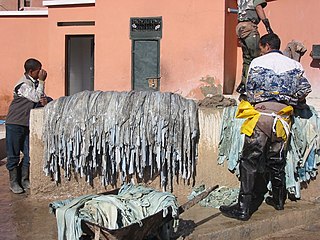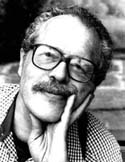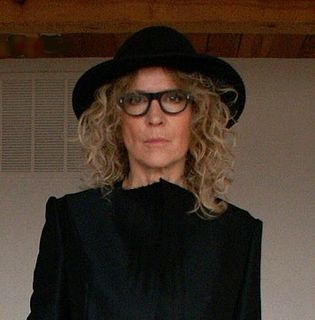Related Research Articles

Max Ernst was a German painter, sculptor, graphic artist, and poet. A prolific artist, Ernst was a primary pioneer of the Dada movement and surrealism. He had no formal artistic training, but his experimental attitude toward the making of art resulted in his invention of frottage—a technique that uses pencil rubbings of objects as a source of images—and grattage, an analogous technique in which paint is scraped across canvas to reveal the imprints of the objects placed beneath. He is also noted for his novels consisting of collages.

Tanning is the process of treating skins and hides of animals to produce leather. A tannery is the place where the skins are processed.

Dorothea Lange was an American documentary photographer and photojournalist, best known for her Depression-era work for the Farm Security Administration (FSA). Lange's photographs influenced the development of documentary photography and humanized the consequences of the Great Depression.

Minnesang was a tradition of lyric- and song-writing in Germany and Austria that flourished in the Middle High German period. This period of medieval German literature began in the 12th century and continued into the 14th. People who wrote and performed Minnesang were known as Minnesänger, and a single song was called a Minnelied.

Suede is a type of leather with a fuzzy, napped finish, commonly used for jackets, shoes, fabrics, purses, furniture, and other items. The term comes from the French gants de Suède, which literally means "gloves from Sweden".

Dick Higgins (1938–1998) was an American artist, composer, art theorist, poet, publisher, printmaker, and a co-founder of the Fluxus international artistic movement. Inspired by John Cage, Higgins was an early pioneer of electronic correspondence. Higgins coined the word intermedia to describe his artistic activities, defining it in a 1965 essay by the same name, published in the first number of the Something Else Newsletter. His most notable audio contributions include Danger Music scores and the Intermedia concept to describe the ineffable inter-disciplinary activities that became prevalent in the 1960s.

The Opening of Misty Beethoven is an American pornographic comedy film released in 1976. It was produced with a relatively high budget and filmed on elaborate locations in Paris, New York City and Rome with a musical score, and owes much to its director Radley Metzger. According to author Toni Bentley, The Opening of Misty Beethoven is considered the "crown jewel" of the Golden Age of Porn (1969–1984).

Alvin Ailey Jr., was an American dancer, director, choreographer, and activist who founded the Alvin Ailey American Dance Theater (AAADT). He created AAADT and its affiliated Ailey School as havens for nurturing Black artists and expressing the universality of the African-American experience through dance. His work fused theater, modern dance, ballet, and jazz with Black vernacular, creating hope-fueled choreography that continues to spread global awareness of Black life in America. Ailey's choreographic masterpiece Revelations is recognized as one of the most popular and most performed ballets in the world.

Dorothea Margaret Tanning was an American painter, printmaker, sculptor, writer, and poet. Her early work was influenced by Surrealism.

John Burke Krasinski is an American actor, director, producer, and screenwriter. He has received four Primetime Emmy Award nominations and won two Screen Actors Guild Awards. He was named by Time magazine as one of the 100 most influential people in the world in 2018.

Anni Albers was an American textile artist and printmaker credited with blurring the lines between traditional craft and art.
Besides surface qualities, such as rough and smooth, dull and shiny, hard and soft, textiles also includes colour, and, as the dominating element, texture, which is the result of the construction of weaves. Like any craft it may end in producing useful objects, or it may rise to the level of art.

John Carter is an American multidisciplinary, conceptual artist and film director, using the professional name Carter for his artworks. He is based in New York City.
Constance DeJong is an American artist, writer, and performer. DeJong produces fiction texts and new media-based work for performance and theater, audio, and video installations. She has permanent audio installations in Beacon, NY, London, and Seattle. She is also known as the writer of the libretto of Philip Glass's opera Satyagraha, as well as her numerous collaborations with Tony Oursler on projects such as Fantastic Prayers. DeJong has exhibited internationally with projects produced by organizations such as the Dia Art Foundation and Minetta Brook. She was a professor of art and time-based media at Hunter College.
Jennifer Morla is a graphic designer and professor based in San Francisco. She received the Cooper Hewitt Smithsonian National Design Award in Communication Design in 2017.
The Foundation for Contemporary Arts (FCA), is a nonprofit based foundation in New York City that offers financial support and recognition to contemporary performing and visual artists through awards for artistic innovation and potential. It was established in 1963 as the Foundation for Contemporary Performance Arts by artists Jasper Johns, John Cage, and others.
Kent Fine Art is an art gallery in New York City founded in 1985 by Douglas Walla.

Jennifer Allen, known professionally as Quilla Constance, is a British contemporary interdisciplinary artist and lecturer, born in Birmingham, 1980.
Dola de Jong was a Jewish Dutch-American writer. She is most well-known for her publication of The Tree and the Vine in 1954, which depicts a lesbian relationship.
Sondra Perry is an interdisciplinary artist who works with video, computer-based media, and performance. She explores themes of race, identity, family history, and technology.

Constance DeJong is a visual artist who works in the margin between sculpture and painting/drawing. Her predominate medium is metal with light as a dominant factor. She is currently working in New Mexico and is a Professor of Sculpture at the University of New Mexico. DeJong received a National Endowment for the Arts Visual Art Fellowship in 1982. In 2003, she had a retrospective at the Albuquerque Museum of Art and History. That same year, Constance DeJong: Metal was published and released by University of New Mexico Press. Her work has been described by American art critic Dave Hickey as "work worth seeing and thinking about under any circumstances".
References
- ↑ "Modern Love: Constance DeJong". 2019-01-23. Retrieved 2019-03-02.
- ↑ Krasinski, Jennifer (2017-04-03). "Constance DeJong by Jennifer Krasinski" . Retrieved 2019-03-02.
- ↑ "Stanford Library" . Retrieved 2019-03-07.
- ↑ Staff, Harriet (2017-03-30). "The History & Reissue of Constance DeJong's Modern Love" . Retrieved 2019-03-02.
- ↑ DeJong, Constance (2017-03-28). "A HISTORY OF MODERN LOVE (AS TOLD BY CONSTANCE DEJONG)" . Retrieved 2019-03-02.